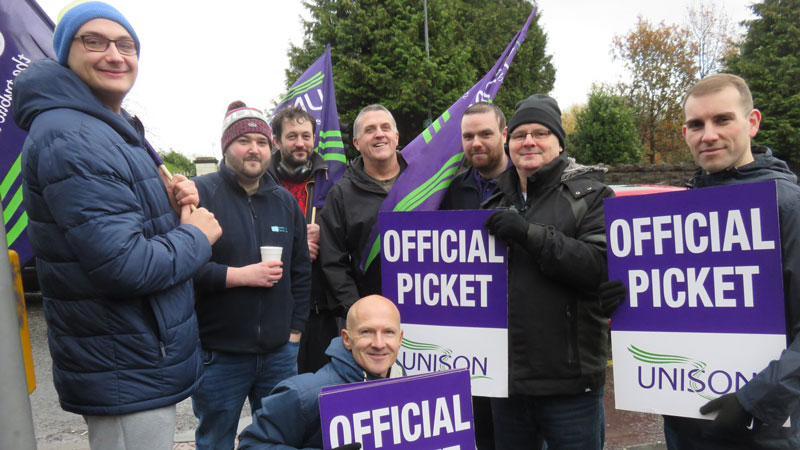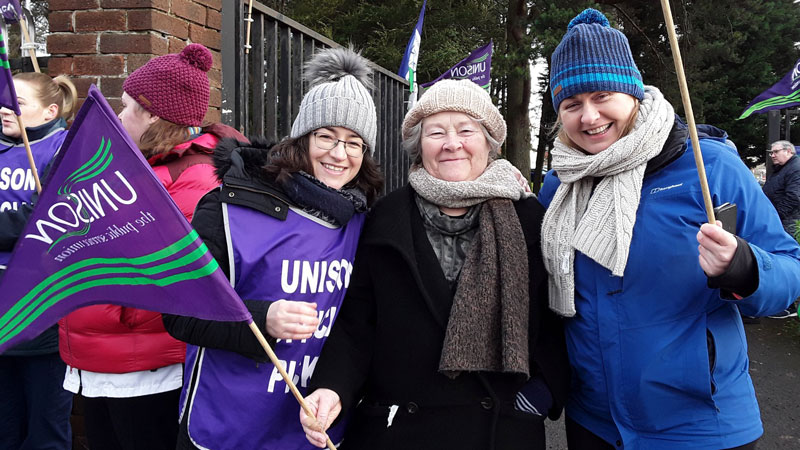It’s the age-old dilemma for trade union members at the sharp end of a dispute: how do you make a stand for your rights, through industrial action, while minimising the impact on your livelihoods and ensuring that service users also don’t suffer?
Just a couple of years ago, UNISON health and social care members in Northern Ireland offered a textbook example of how to do exactly that – and win.
It wasn’t easy, requiring leadership, creativity and determination from the grassroots. But, as one of the leaders of the action recalls, the results are truly inspiring.
In 2019, NHS staff in Northern Ireland were on less pay than their counterparts in England, Scotland and Wales. After two consecutive 1% non-consolidated awards, they were very much on the back foot.
UNISON, which represented 26,000 members across health and social care, reasonably believed this was unfair and unacceptable. The union also felt that poor staffing levels was having a negative impact both on members and patients.
The fact that the devolved Northern Ireland Executive in Stormont had collapsed wasn’t making matters any easier. And negotiations with the civil servants then running the country were going nowhere.
The industrial action committee
Maura McKenna was and is co-chair of the UNISON Northern Ireland health committee and vice-chair of the union’s health service group executive. She’s also chair of the North and West Belfast Community branch. She recalls the dilemma faced by all 19 NI health branches and the first, key decision they made: to set up an industrial action committee to plan the way forward.
“We didn’t want to bring all of our low-paid members out for weeks of losing money,” she says. “They couldn’t have afforded it, especially coming up to Christmas. They were already getting paid less than everybody else to start off with, and we didn’t want to exacerbate that.
“So our question was: what would have the most impact on the employer but the least impact on the members? We came up with the idea that, instead of taking everybody out all at once, we’d take out different disciplines, different trusts, different areas – on different days.
“We floated the idea to the region, explaining what we wanted to do, that we thought it was the most deliverable, that it would cause complete havoc for employers and have the least impact on our members.”
The regional committee approved the plan, with its total support. It then had to be put to the membership. Before the industrial action ballot, branch activists held member meetings, explaining the strategy, particularly the aim to minimise the effect on individuals.
On 11 November, 23% of UNISON members took part in a single, Northern Ireland-wide ballot on industrial action, with 92% voting in favour of striking.
For the rest of the UK, 23% would not be enough to green light industrial action. A 50% turnout would be required, with 40% of all members – voting or not – in favour of action
The action
Industrial action began on Monday 25 November 2019, with no stated end date. As Maura puts it: “The end date was whenever we received pay parity [with the other nations] and safe staffing.”
How better to underscore the message than on that first day, with the presence on the picket line at Ulster Hospital of Pauline Symington, a domestic services worker who had just received the prestigious Skills for Health Support Worker Award 2019 – an award covering the NHS across the whole of the UK.
It was a bold plan, involving the whole region, five health trusts, the ambulance service and arms- length bodies, and of course thousands of staff. That was all the more reason why it required careful planning, top-notch organisation and teamwork.
UNISON’s regional staff offered strong support all the way, from issuing dispute notices to employers to providing campaign materials to the strikers, assisting with the mobilisation of picket lines and dealing with mainstream and social media, to ultimately delivering at the negotiating table.
But this action had to be led by the branches, Maura says. “It was the branches that made the decision where and when the action was going to take place. We knew what’s happening, we knew who we could get out and we knew what the impact would be.”

The first thing the organisers did was establish which services would be ‘derogated’ – untouched by the action – such as cancer services, children’s services, critical care. With those put aside, the aim was for the rest of the workforce to embark on industrial action short of strike, on top of which would be dozens of small, targeted strikes.
The union sent out as many as 600 notices of strike action a week – always with the required one week’s notice, but no more, to heighten the effect.
So in that first week, drivers were taken out at two trusts, the post room staff in two others, admin and clerical, and nurses elsewhere. Since Northern Ireland has an integrated service, the action committee realised they could double the impact with half the resource.
As Maura explains: “If we take out bus drivers, they can’t transport the clients into the day centres, so in actual fact the staff in the day centres have nothing to do – but they don’t lose any wages. Then whenever the day centre staff came out, the bus drivers couldn’t bring the clients in, so they had no work to do. So it worked like that, you didn’t take them all out, you only took one element of them out.”
The branches would get together every other week, to assess how things were going and if there were new ideas going forward. All the while, the union’s regional webpage kept members informed of the picketing schedules, public statements made by the union, and advice covering everything from what ‘work to rule’ means in practice, to a table showing the pay disparities across countries, and personal video accounts of why individual members believed in the strike.
A new kind of picket line
More than a strategy, there was an ethos, one that moved away from the customary, hard-line language of the picket line.
“Everybody was part of the industrial action – even those who went into work,” says Maura. “If you weren’t in the list for the week’s action, you went in. We made it very clear from the word go that this wasn’t a case of ‘crossing a picket line’. We had to make sure that everybody understood: when you weren’t out, you weren’t out, so you were able to go pass the picket line and into work.”
She laughs, now, at the response this approach garnered from some members. “We got to the stage where we had members phoning us and asking ‘When’s it our turn?!’ Seriously, it was unbelievable. We had to go onto the wards and say ‘Please. You may come out at a later date, but we need you in work now’.”

What these eager members did, instead, was join the picket before or after their shifts, or during their lunch breaks. And they weren’t the only ones – because the public were there in numbers as well, bringing teas, coffees and snacks to the strikers and showing their support.
Winning the public over to the cause had also been part of the plan. Maura’s favourite approach was borrowed from the Oscar-winning film Three Billboards Outside Ebbing, Missouri.
“A lot of our branches paid for billboards, which we had placed all over Northern Ireland. Make sure your voice is heard, or A nurse here is being paid this much less than a nurse in Scotland or A domestic is paid this much in Belfast but in London….
“We focused on the idea of being left behind, and the public supported it 100%. We had so many comments on our Facebook pages, we had letters, we were sent cards and letters with money. When we were getting on the buses to Stormont, for a protest at the department of health building, we had public coming along and saying good luck. Some of them came along to the protest – they asked if they could get on the buses with us!”
It turned out that the public were not the only ones supporting the health staff – the employers did too. Maura remembers the first night of the strike. As certain sections of the staff at the Royal Victoria Hospital in Belfast were walking off the wards, they were greeted in the foyer by the trust’s chief executive, with flasks of tea and coffee.
“The employers supported us, because they knew it was wrong. But they had no power to deliver the money.” More than that, many HE departments were reporting to managers the need for safe staffing and, in some cases, better treatment of staff, which would have a long-term, positive impact after the action was concluded.
On 18 December, after more than three weeks of continuous UNISON action, its members were joined for a day by the nurses of the Royal College of Nursing, for a one-day strike that was that union’s first in its 103-year history.
Success
UNISON’s members doggedly continued over Christmas and the New Year. Then on 15 January 2020, less than a week after the return of the Northern Ireland Executive, the union met with the new health minister and agreed a framework agreement that achieved both of its demands – for pay parity and safe staffing levels. Maura fondly recalls that Anne Speed, the region’s head of bargaining and representation, wouldn’t leave Stormont until the final document had been signed off, at 10pm that evening.
And the next day the union ended as it had started, balloting members on whether they wanted to accept.
Looking back, Maura believes that the approach to the pay strike in Northern Ireland created a real sense of ownership amongst members, of the action itself. “We gained new membership and we also gained new reps,” she says, “because they saw the way it played out, the way we interacted with our membership.”
She recalls one occasion with particular affection, when members of her own branch, who worked at a day centre for people with learning disabilities, turned one of their strike days into a party outside – with members dancing the conga in the pouring rain, local businesses sending them tea and coffee, burgers and chips. One of the organisers that day was Collette O’Hanlon, not long after she’d taken up the role of joint branch secretary.
As for the mechanics of the action’s success, Maura says proudly: “For the space of six or seven weeks the employers were in panic mode, continually, because they didn’t know what we were going to hit them with next. It was a long, sustained industrial action. But do you know, over the whole period of time, I think the most that any of our members lost was two days pay.”
* At time of writing, health and social care members in Northern Ireland had not yet received a formal pay outcome for 2021/22

